RAPID ALKALINIZATION FACTOR 22 is a key modulator of the root hair growth responses to fungal ethylene emissions in Arabidopsis
- PMID: 39283986
- PMCID: PMC11773001
- DOI: 10.1093/plphys/kiae484
RAPID ALKALINIZATION FACTOR 22 is a key modulator of the root hair growth responses to fungal ethylene emissions in Arabidopsis
Abstract
In Arabidopsis (Arabidopsis thaliana (L.) Heynh), exposure to volatile compounds (VCs) emitted by Penicillium aurantiogriseum promotes root hair (RH) proliferation and hyper-elongation through mechanisms involving ethylene, auxin, and photosynthesis signaling. In addition, this treatment enhances the levels of the small signaling peptide RAPID ALKALINIZATION FACTOR 22 (RALF22). Here, we used genetics to address the role of RALF22 in fungal VC-promoted RH growth and to identify the bioactive fungal VC. We found that RHs of ralf22 and feronia (fer-4) plants impaired in the expression of RALF22 and its receptor FERONIA, respectively, responded weakly to fungal VCs. Unlike in wild-type roots, fungal VC exposure did not enhance RALF22 transcript levels in roots of fer-4 and ethylene- and auxin-insensitive mutants. In ralf22 and fer-4 roots, this treatment did not enhance the levels of ERS2 transcripts encoding one member of the ethylene receptor family and those of some RH-related genes. RHs of ers2-1 and the rsl2rsl4 double mutants impaired in the expression of ERS2 and the ethylene- and auxin-responsive ROOT HAIR DEFECTIVE 6-LIKE 2 and 4 transcription factors, respectively, weakly responded to fungal VCs. Moreover, roots of plants defective in photosynthetic responsiveness to VCs exhibited weak RALF22 expression and RH growth responses to fungal VCs. VCs of ΔefeA strains of P. aurantiogriseum cultures impaired in ethylene synthesis weakly promoted RH proliferation and elongation in exposed plants. We conclude that RALF22 simultaneously functions as a transcriptionally regulated signaling molecule that participates in the ethylene, auxin, and photosynthesis signaling-mediated RH growth response to fungal ethylene emissions and regulation of ethylene perception in RHs.
© The Author(s) 2024. Published by Oxford University Press on behalf of American Society of Plant Biologists. All rights reserved. For commercial re-use, please contact reprints@oup.com for reprints and translation rights for reprints. All other permissions can be obtained through our RightsLink service via the Permissions link on the article page on our site—for further information please contact journals.permissions@oup.com.
Conflict of interest statement
Conflict of interest statement. None declared.
Figures

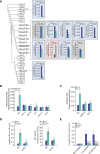
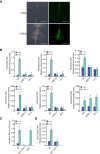
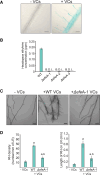
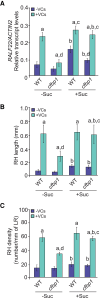
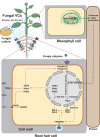
References
-
- Ahammed GJ, Li X. Elevated carbon dioxide-induced regulation of ethylene in plants. Environ Exp Bot. 2022:202:105025. 10.1016/j.envexpbot.2022.105025 - DOI
-
- Ameztoy K, Sánchez-López ÁM, Muñoz FJ, Bahaji A, Almagro G, Baroja-Fernández E, Gámez-Arcas S, De Diego N, Doležal K, Novák O, et al. Proteostatic regulation of MEP and shikimate pathways by redox-activated photosynthesis signalling in plants exposed to small fungal volatiles. Front Plant Sci. 2021:12:637976. 10.3389/fpls.2021.637976 - DOI - PMC - PubMed
MeSH terms
Substances
Grants and funding
LinkOut - more resources
Full Text Sources

